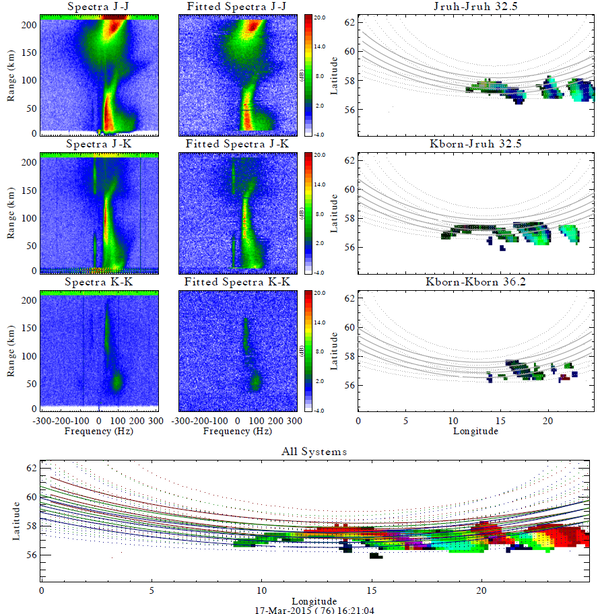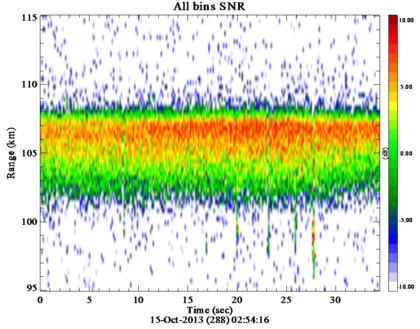- Research Topics
- Department Optical and Rocket Soundings
- Department Radar Remote Sensing
- Department Modelling of Atmospheric Processes
- Working Group Satellite Data Analysis
- Cross-departmental Collaborations
- Projects
- Publications
E-region echoes
The E region is the atmospheric/ionospheric region between 90 and 150 km and forms part of what is known the lower thermosphere. The lower thermosphere influences the mesosphere and even the upper stratosphere and viceversa. Some physical processes of general relevance appear specifically pronounced here, e. g., wave mixing and generation of secondary gravity waves. This region is dynamically coupled to the mesosphere and lower atmospheric regions by gravity waves, tides, and planetary waves which propagate upward from below and often dissipate in the 80 to 150-km region. To explore this region with IAP radars, we make use of the following systems: (a) MAARSY, (b) Juliusruh ionosonde, and (c) MMARIA networks.
In the case of MAARSY one can study the E region sporadically from the following echoes: (a) Incoherent scatter echoes when the electron density sufficiently enhances (see Figure 1), (b) non-specular meteor echoes (e.g., Chau et al., 2014), (c) strong echoes from sporadic layers (e.g., Rapp et al., 2011), and (d) radar aurora echoes. Although the latter would usually come from sidelobes and experience significant refraction.
The Juliusruh ionosonde help us to explore the E-region over northern Germany by measuring the E region electron density and strong sporadic E-layers. These measurements are done routinely since more than 50 years ago.
In the case of MMARIA networks, although their main targets are specular meteor echoes, they can also be used to study the E region when the coherent echoes, particularly those due to field-aligned irregularities, are strong enough. An example of E region echoes observed during the March 17 2015 magnetic storm (i.e., the 2015 St. Patrick storm), can be found in Figure 2. These observations were made with an initial MMARIA-Germany setup consisting of three links, working at two different frequencies. The first two columns show the measured and fitted spectra for all three links. The third column shows the location, based on interferometry, of echoes at all three links, overplotted over the expected loci of perpendicularity with the magnetic field around E region altitudes. Specific details of these observations and their theoretical interpretation can be found in Chau and St. Maurice [2016] and St. Maurice and Chau [2016], respectively.
In the case of MMARIA stations at mid latitudes (e.g., MMARIA Germany, SIMONe Argentina), radar aurora-like E region echoes can be observed during strong magnetic storms (Kp > 6). In the case of low latitude stations (e.g., SIMONe Peru), E region echoes can be observed frequently during the daytime from irregularities associated to the equatorial electrojet.

Publications
- Chau, J. L., I. Strelnikova, C. Schult, M. M. Oppenheim, M. C. Kelley, G. Stober, and W. Singer, Non-specular meteor trails from non-field-aligned irregularities: can they be explained by presence of charged meteor dust?, Geophys. Res. Lett, doi: 10.1002/2014GL059922, 2014.
- Chau, J. L. and J. P. St. Maurice, Unusual 5-m E region observed at mid-latitudes during the March 17, 2015 storm with the use of multi-static, multi-frequency VHF radar links, J. Geophys. Res., doi:10.1002/2016JA023104, 2016.
- Rapp, M., L. Leitert, R. Latteck, M. Zecha, P. Hoffmann, J. Höffner, U.-P. Hoppe, C. La Hoz und E. V. Thrane, Localized mesosphere-stratosphere-troposphere radar echoes from the E-region at 69° N: Properties and physical mechanism, J. Geophys. Res., 116, A02320, doi:10.1029/2010JA016167, 2011
- St. Maurice, J. P. and J. L. Chau, A theoretical framework for the changing spectral properties of meter-scale Farley-Buneman waves between 90 and 125 km altitudes, J. Geophys. Res., doi:10.1002/2016JA023105, 2016.













